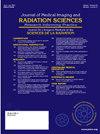Feasibility of Therapist-Driven MR-guided Adaptive Radiotherapy for Oligometastatic Disease
IF 2
Q3 RADIOLOGY, NUCLEAR MEDICINE & MEDICAL IMAGING
Journal of Medical Imaging and Radiation Sciences
Pub Date : 2025-05-01
DOI:10.1016/j.jmir.2025.101927
引用次数: 0
Abstract
Purpose/Aim
A major limitation in most adaptive radiation therapy (ART) applications is the need for daily, online re-contouring by radiation oncologists (RO) due to the associated human resource implications. This has been overcome for prostate MR-guided ART via successful implementation of radiation therapist (RTT) led workflows. With increasing utilization of MR-guided adaptive stereotactic body radiation therapy (SBRT) in oligometastatic disease, we evaluated a potential RTT-led workflow by comparing geometric accuracy and dosimetric uncertainty between RO and RTT re-contouring.
Methods/Process
Five RTTs and five ROs retrospectively re-contoured all target and organ-at-risk (OAR) volumes within a 2 cm ring of the target for eight oligometastatic disease cases. Consensus RO contours were generated for targets and OARs via the Simultaneous Truth and Performance Level Estimation (STAPLE) method and geometric accuracy was evaluated for each RTT and each RO contour versus the RO-STAPLE contour using Dice similarity coefficient (DICE) and Hausdorff mean distance to agreement (MDA). Additionally, a RO qualitatively scored all contours blinded to profession using a 5-point Likert scale. Furthermore, dosimetric impact of re-contouring was assessed against the RO-STAPLE contours using planning target volume (PTV) D95 and OAR D0.5cc. The Wilcoxon signed rank was used to determine statistical significance.
Results or Benefits/Challenges
Mean (±standard deviation) GTV DICE were 0.82±0.06 for RTTs and 0.85±0.09 for ROs, and MDA was 0.88±0.03 mm for RTTs and 0.75±0.05 mm for ROs relative to the RO-STAPLE. Qualitative GTV scores were excellent with Likert scores of 4.8/5 for RTTs and 4.7/5 for ROs. Mean change in PTV D95 from RO-STAPLE small but statistically significantly higher for RTTs (0.5±1.5%) compared to ROs (-0.7±1.9%, p<0.05). OARs assessed had high DICE and MDA scores for both RTTs and ROs. Dosimetric results for the OAR D0.5cc showed a mean relative change of –1.1±6% for RTTs and -1.1±12% for ROs.
Conclusions/Impact
Our results show that RTT re-contouring maintains similar performance for both targets and OARs compared with RO contours and establishes the feasibility of an RTT-led workflow. An RTT-led MR-guided online adaptive oligometastatic disease workflow has potential to decrease the resource burden for this valuable technique and improve access to MR-guided radiotherapy techniques.
低转移性疾病的适应性放射治疗的可行性
目的/目的:大多数适应性放射治疗(ART)应用的主要限制是由于相关的人力资源问题,放射肿瘤学家(RO)需要每天在线重新轮廓。通过成功实施放射治疗师(RTT)领导的工作流程,前列腺磁共振引导的ART已经克服了这一问题。随着磁共振引导的适应性立体定向体放射治疗(SBRT)在低转移性疾病中的应用越来越多,我们通过比较RTT和RTT重新轮廓之间的几何精度和剂量不确定性,评估了RTT主导的潜在工作流程。5个rtt和5个ROs回顾性地重新绘制了8例低转移性疾病患者靶标周围2 cm范围内的所有靶标和危险器官(OAR)体积。通过同步真实性和性能水平估计(STAPLE)方法为目标和桨生成一致的RO轮廓,并使用Dice相似系数(Dice)和Hausdorff平均一致距离(MDA)评估每个RTT和每个RO轮廓与RO-STAPLE轮廓的几何精度。此外,RO使用5分李克特量表对职业盲视的所有轮廓进行定性评分。此外,使用计划目标体积(PTV) D95和OAR D0.5cc评估重新轮廓对RO-STAPLE轮廓的剂量学影响。采用Wilcoxon符号秩来确定统计显著性。 结果或益处/挑战相对于RO-STAPLE, rtt的平均(±标准差)GTV DICE为0.82±0.06,ROs为0.85±0.09,rtt的MDA为0.88±0.03 mm, ROs为0.75±0.05 mm。定性GTV评分优秀,rtt的Likert评分为4.8/5,ROs为4.7/5。RO-STAPLE对PTV D95的平均变化较小,但rtt组(0.5±1.5%)比ROs组(-0.7±1.9%,p<0.05)有统计学意义。评估的OARs在rtt和ROs中均有较高的DICE和MDA评分。OAR D0.5cc的剂量学结果显示,rtt和ROs的平均相对变化为-1.1±6%和-1.1±12%。 结论/ImpactOur结果表明,与RO轮廓相比,RTT重新轮廓对目标和桨都保持了相似的性能,并建立了RTT主导工作流程的可行性。rtt引导的磁共振引导在线自适应低转移性疾病工作流程有可能减少这一有价值技术的资源负担,并改善磁共振引导放射治疗技术的可及性。
本文章由计算机程序翻译,如有差异,请以英文原文为准。
求助全文
约1分钟内获得全文
求助全文
来源期刊

Journal of Medical Imaging and Radiation Sciences
RADIOLOGY, NUCLEAR MEDICINE & MEDICAL IMAGING-
CiteScore
2.30
自引率
11.10%
发文量
231
审稿时长
53 days
期刊介绍:
Journal of Medical Imaging and Radiation Sciences is the official peer-reviewed journal of the Canadian Association of Medical Radiation Technologists. This journal is published four times a year and is circulated to approximately 11,000 medical radiation technologists, libraries and radiology departments throughout Canada, the United States and overseas. The Journal publishes articles on recent research, new technology and techniques, professional practices, technologists viewpoints as well as relevant book reviews.
 求助内容:
求助内容: 应助结果提醒方式:
应助结果提醒方式:


